|
|
|
JOHN
STORER RESIDENCE (1923 - S.215) |
|
|
|
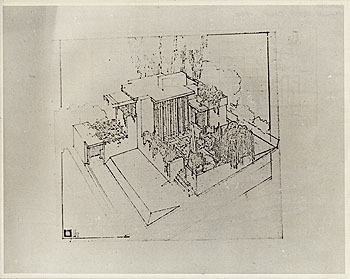 |
Date: 1922
Title: Charles P. Lowes Residence, Los
Angeles, Perspective 1922 (Project 1922 - FLLW#2202).
Description: Photograph of original drawing in
the Frank Lloyd Wright Archives. Aerial perspective of the Lowes
Residence, designed by Frank Lloyd Wright in 1922. Although it
remained a project, a year later it was revived as a textile
block house and built as the Storer House
(1923 - S.215). In 1925 Wright published four renderings of the
Lowes Residence in
The Life-Work of
the American Architect Frank Lloyd Wright, p.56-59. Also
published in
Wright, 1917-1942,
Pfeiffer, 2010, p.79.
Size:
Original 8 x 10 B&W
photograph.
S#:
0147.23.1219 |
|
|
|
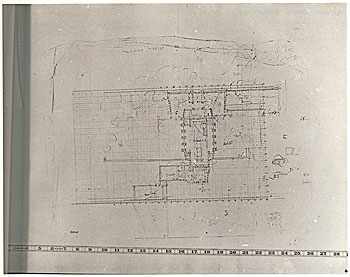 |
Date: 1922
Title: Charles P. Lowes Residence, Los
Angeles, Ground Plan 1922 (Project 1922 - FLLW#2202).
Description: Photograph of original drawing in
the Frank Lloyd Wright Archives. Early ground plan for the Lowes
Residence, designed by Frank Lloyd Wright in 1922. Although it
remained a project, a year later it was revived as a textile
block house and built as the Storer House
(1923 - S.215). In 1925 Wright published four renderings of the
Lowes Residence in
The Life-Work of
the American Architect Frank Lloyd Wright, p.56-59. Text
bottom left: "2202.01"
Size:
Original 8 x 10 B&W
photograph.
S#:
0147.24.1219 |
|
|
|
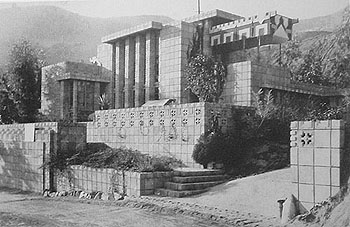 |
Date:
1924
Title:
John Storer Residence, Circa
1924 (1923 - S.215).
Description:
Viewed from the Southeast. Designed by Frank Lloyd Wright
in 1923, the home was completed in 1924. Most likely photographs
shortly after the completion of construction. Wright's son Lloyd
Wright supervise the construction of the home as well as
designing the landscape. The entrance of the home is reached by
the stairs in the foreground. Possibly photographed by Kameki
Tsuchiura. Published in Wright in Hollywood, Sweeney, p.63.
Size: 7 x 5 B&W Photograph.
S#:
0164.01.1016 |
|
|
|
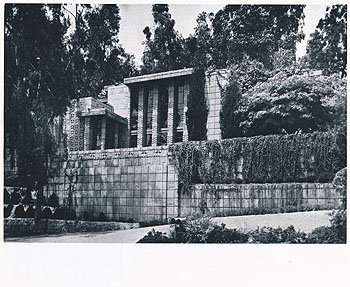 |
Date:
Circa
1940
Title:
John Storer Residence, Circa 1940 (1923 - S.215).
Description: Viewed from the Southeast. Designed
by Frank Lloyd Wright in 1923, the home was completed in 1924.
Published in "In The
Nature of Materials", Hitchcock, 1942, plate 255. Clipping
pasted to verso: "Looser and freer in design than ‘La Minitura,’
the house built for Dr. John Storer in Los Angeles rises in a
multiplane series of concrete block walls. Constructed in 1923,
most of it can be seen from the street." Stamped on clipping:
"Su Dec 12 1965." Stamped on verso: "1965 Nov 3."
Size:
Original 10 x 8 B&W photograph.
S#:
0531.80.0719 |
|
|
|
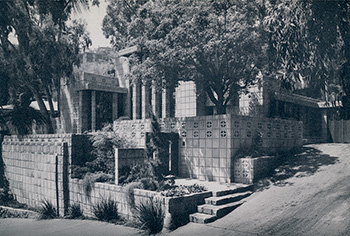 |
Date:
Circa
1953
Title:
Storer
Residence, Hollywood, CA, Circa 1953 (1923 - S.215).
Description: Postcard.
Viewed from the Southeast. Designed by Frank Lloyd Wright in
1923, the home was completed in 1924. The Storer Residence was
Frank Lloyd Wright's second textile block home in California.
The house was originally designed in 1922 for Charles P. Lowes,
Eagle Rock, California, but was never built. Wright adapted the
plan, made modifications and designed it for the Storer
property. A two-story home, the Entrance, Dining Room, Kitchen,
two Bedrooms and Terraces are on the main floor. The upper level
includes the Living Room, directly above the Dining Room, two
bedrooms as well as two Terraces. Wright's son Lloyd Wright
supervise the construction of the home. There are four different
textile blocks designs were used to construct the Storer House
and are 16" x 16" square. Glass was added to the perforated
blocks allowing additional light in, creating patters of light
on the interior. Glass was added to the exterior perforated
blocks, and illuminated at night. Wright also added landscape
walls to create Terraces and Planting areas surround the house.
Horizontal and vertical steel rods were woven around each block.
The horizontal and vertical grooves between each block were
filled with concrete, locking the blocks in place.
Text on Verso:
“Frank Lloyd Wright, Architect. Storer House: 1923, Los Angeles, California.
Photograph: Julius Shulman. 25-6300-2. Published by Museum Resources.
Rimrock, California.”
Size:
6 x 4 B&W Postcard.
S#:
0987.140.1125 |
|
|
|
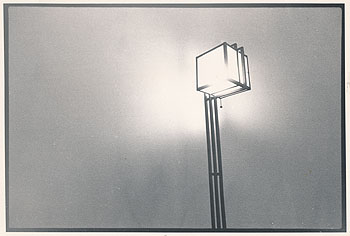 |
Date:
1982
Title:
John Storer Residence Floor Lamp 1982 (1923 - S.215).
Description: View of the John Storer Residence
Floor Lamp at the Whitney Art Museum. Designed by F4rank Lloyd
Wright in 1923. The Whitney Museum of American Art exhibited
Furniture by American Architects held November 12 , 1982 -
January 26 , 1983 at the Fairfield County branch in Stamford ,
Connecticut. Entitled "Shape and Environment, an Exhibit of
Modern Furniture Design." Label pasted to verso: "Date,
Wednesday November 10, (1982). Title: Frank Lloyd Wright’s metal
tubing and glass lamp, 1923. Subject: Shape and Environment
Exhibit of Modern Furniture Design. For Living Section – Cover
on Furniture by Architects. Photographer: Tutko." An original
drawing of the lamp by Wright in the Avery Library is numbered
FLLW: 2304.019. See S#1990.163,
1990.164,
1990.169. This lamp also appeared in early photographs
of the Samuel Freeman House published in
Frank Lloyd Wright Interiors and
Furniture, Heinz, 1994, p.174-175. An original lamp sold at
the Wright Auction, Chicago, on November 17, 2016, for $100,000.
Constructed of copper-plated cast iron, brass and glass.
Original lamp: 76.25 H x 8 W x 9 D.
See other Wright Furniture and
chairs...
Size:
Original 10 x 8 B&W photograph.
ST#:
1982.68.1121 |
|
|
|
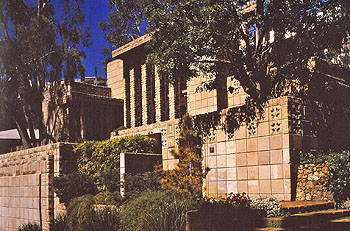 |
Date:
Circa 1990
Title:
1) John Storer Residence, Hollywood, CA.,
Exterior Circa 1990 (1923 - S.215).
Description:
View of the front facade from the
Southeast. Designed by Frank Lloyd Wright in 1923. Copy of
photograph published in
Frank Lloyd Wright Select
Houses 8, Pfeiffer, 1991,
p.69. Text on sleeve: "Wright, F. L. - Storer House, 4-1. Storer
House. Ext., view of street. Hollywood, CA., USA, 1923. Wright,
Frank Lloyd. U of Virginia FAIC." Acquired from the archives of
the University of Virginia.
Size:
35mm Color slide, sandwiched between
glass, plastic mount.
ST#:
1990.159.0520 |
|
|
|
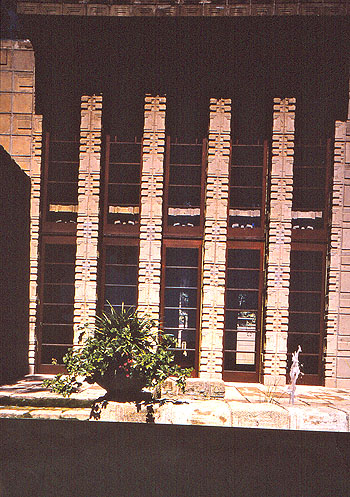 |
Date:
Circa 1990
Title:
2) John Storer Residence, Hollywood, CA., Exterior Circa 1990
(1923 - S.215).
Description: View of the front facade from the
South. The Entrance is on the left. The Dining Room is on the
lover level, the Living Room on the second level. Designed by
Frank Lloyd Wright in 1923. Copy of photograph published in
Frank Lloyd Wright Select
Houses 8, Pfeiffer, 1991, p.72. Text on sleeve: "Wright,
F. L. - Storer House, 4-2. Storer House. Ext., entrance.
Hollywood, CA., USA, 1923. Wright, Frank Lloyd. U of Virginia
FAIC." Acquired from the archives of the University of Virginia.
Size:
35mm Color slide, sandwiched between
glass, plastic mount.
ST#:
1990.160.0520 |
|
|
|
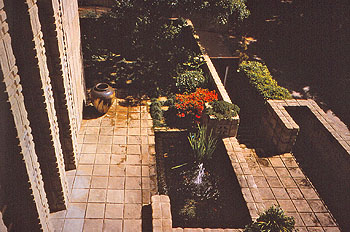 |
Date:
Circa 1990
Title:
3) John Storer Residence, Hollywood, CA., Exterior Circa 1990
(1923 - S.215).
Description: View of the front Terrace and
fountain from the West, from the Living Room Terrace. The street
is on the right. Designed by Frank Lloyd Wright in 1923. Copy of
photograph published in
Frank Lloyd Wright Select Houses 8, Pfeiffer, 1991,
p.73. Text on sleeve: "Wright, F. L. - Storer House, 4-3. Storer
House. Ext., view of entrance from living room terrace.
Hollywood, CA., USA, 1923. Wright, Frank Lloyd. U of Virginia
FAIC." Acquired from the archives of the University of Virginia.
Size:
35mm Color slide, sandwiched between
glass, plastic mount.
ST#:
1990.161.0520 |
|
|
|
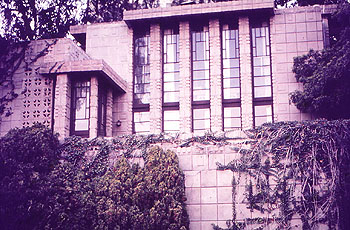 |
Date:
Circa 1990
Title:
4) John Storer Residence, Hollywood, CA., Exterior Circa 1990
(1923 - S.215).
Description: View of the front facade from the
South. The Bedroom is on the left. The Dining Room is on the
lover level, the Living Room on the second level. Designed by
Frank Lloyd Wright in 1923. Text on sleeve: "Wright, F. L. -
Storer House, 4-4. Storer House. Ext., living room. Hollywood,
CA., USA, 1923. Wright, Frank Lloyd. U of Virginia FAIC."
Acquired from the archives of the University of Virginia.
Size:
35mm Color slide, sandwiched between
glass, plastic mount.
ST#:
1990.162.0520 |
|
|
|
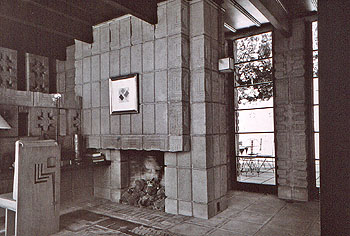 |
Date:
Circa 1990
Title:
5) John Storer Residence, Hollywood, CA., Interior Entry
Fireplace Circa 1990 (1923 - S.215).
Description: View of the entry fireplace. The
Midway Garden table and chairs on the terrace were manufactured
in 1986 by Cassina. The Dining Room table is to the right.
Designed by Frank Lloyd Wright in 1923. Copy of photograph
published in Frank Lloyd
Wright Select Houses 8, Pfeiffer, 1991, p.77. Text on
sleeve: "Wright, F. L. - Storer House, 5-1. Storer House. Int.,
fireplace and terrace. Hollywood, CA., USA, 1923. Wright, Frank
Lloyd. U of Virginia FAIC." Acquired from the archives of the
University of Virginia.
Size:
35mm Color slide, sandwiched between
glass, plastic mount.
ST#:
1990.163.0520 |
|
|
|
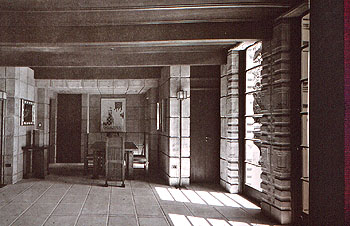 |
Date:
Circa 1990
Title:
6) John Storer Residence, Hollywood, CA., Interior Dining Room
Circa 1990 (1923 - S.215).
Description: View of the Dining Room from the
West. Designed by Frank Lloyd Wright in 1923. Copy of photograph
published in Frank Lloyd
Wright Select Houses 8, Pfeiffer, 1991, p.74. Text on
sleeve: "Wright, F. L. - Storer House, 5-2. Storer House. Int.,
dining room. Hollywood, CA., USA, 1923. Wright, Frank Lloyd. U
of Virginia FAIC." Acquired from the archives of the University
of Virginia.
Size:
35mm Color slide, sandwiched between
glass, plastic mount.
ST#:
1990.164.0520 |
|
|
|
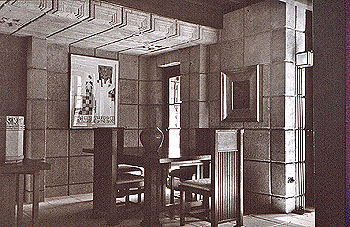 |
Date:
Circa 1990
Title:
7) John Storer Residence, Hollywood, CA., Interior Dining Room
Circa 1990 (1923 - S.215).
Description: View of the Dining Room from the
Northwest. Designed by Frank Lloyd Wright in 1923. Copy of
photograph published in
Frank Lloyd Wright Select Houses 8, Pfeiffer, 1991,
p.75. Text on sleeve: "Wright, F. L. - Storer House, 5-7. Storer
House. Int., dining room. Hollywood, CA., USA, 1923. Wright,
Frank Lloyd. U of Virginia FAIC." Acquired from the archives of
the University of Virginia.
Size:
35mm Color slide, sandwiched between
glass, plastic mount.
ST#:
1990.169.0520 |
|
|
|
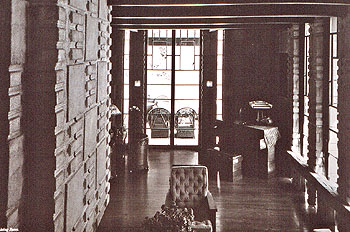 |
Date:
Circa 1990
Title:
8) John Storer Residence, Hollywood, CA., Interior Living Room
Circa 1990 (1923 - S.215).
Description: View of the Living Room from the
West. Designed by Frank Lloyd Wright in 1923. Copy of photograph
published in Frank Lloyd
Wright Select Houses 8, Pfeiffer, 1991, p.80. Text on
sleeve: "Wright, F. L. - Storer House, 5-3. Storer House. Int.,
living room. Hollywood, CA., USA, 1923. Wright, Frank Lloyd. U
of Virginia FAIC." Acquired from the archives of the University
of Virginia.
Size:
35mm Color slide, sandwiched between
glass, plastic mount.
ST#:
1990.165.0520 |
|
|
|
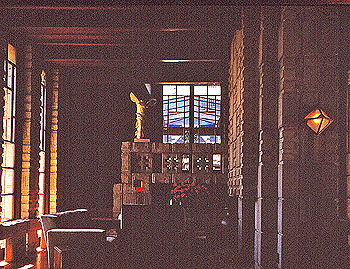 |
Date:
Circa 1990
Title:
9) John Storer Residence, Hollywood, CA., Interior Living Room
Circa 1990 (1923 - S.215).
Description: View of the Living Room from the
East. Designed by Frank Lloyd Wright in 1923. Copy of photograph
published in Frank Lloyd
Wright Select Houses 8, Pfeiffer, 1991, p.82. Text on
sleeve: "Wright, F. L. - Storer House, 5-4. Storer House. Int.,
living room. Hollywood, CA., USA, 1923. Wright, Frank Lloyd. U
of Virginia FAIC." Acquired from the archives of the University
of Virginia.
Size:
35mm Color slide, sandwiched between
glass, plastic mount.
ST#:
1990.166.0520 |
|
|
|
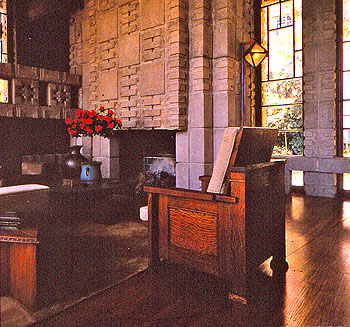 |
Date:
Circa 1990
Title:
10) John Storer Residence, Hollywood, CA., Interior Living Room
Circa 1990 (1923 - S.215).
Description: View of the Living Room from the
Southeast. Designed by Frank Lloyd Wright in 1923. Copy of
photograph published in
Frank Lloyd Wright Select Houses 8, Pfeiffer, 1991,
p.83. Text on sleeve: "Wright, F. L. - Storer House, 5-5. Storer
House. Int., living room and fireplace. Hollywood, CA., USA,
1923. Wright, Frank Lloyd. U of Virginia FAIC." Acquired from
the archives of the University of Virginia.
Size:
35mm Color slide, sandwiched between
glass, plastic mount.
ST#:
1990.167.0520 |
|
|
|
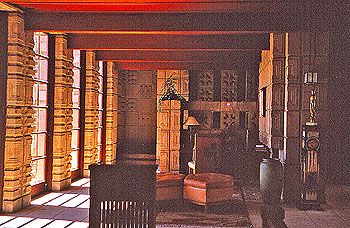 |
Date:
Circa 1990
Title:
11) John Storer Residence, Hollywood, CA., Interior Living Room
Circa 1990 (1923 - S.215).
Description: View of the Entrance and firplace
from the East. Designed by Frank Lloyd Wright in 1923. Copy of
photograph published in
Frank Lloyd Wright Select Houses 8, Pfeiffer, 1991,
p.76. Text on sleeve: "Wright, F. L. - Storer House, 5-6. Storer
House. Int., dining room and entrance. Hollywood, CA., USA,
1923. Wright, Frank Lloyd. U of Virginia FAIC." Acquired from
the archives of the University of Virginia.
Size:
35mm Color slide, sandwiched between
glass, plastic mount.
ST#:
1990.168.0520 |
|
|
|
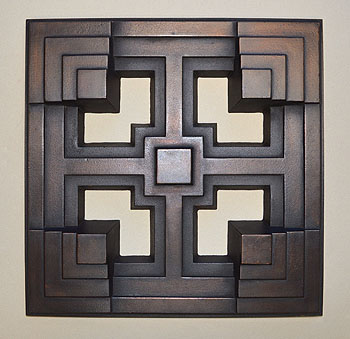 |
Date:
1992
Title:
Storer House Block, 1992 (1923 - S.215).
Description:
Designed in 1923 for the John Storer
House, this decorative panel is a reproduction of a concrete block
that was used though out the house. Wright's idea for the Storer
House and other in the area, was to create a building system that
was unique and indigenous to the area in which he was building, in
this way, he said the building would be "organic" He created a
system of construction in which individual cast concrete blocks were
"wove" together to create the "fabric" of the house. Many of the
blocks had plain, flat surfaces, however other were modeled to
create interesting shadows and textures, both on the interior and
the exterior. Our block is a perforated, patterned block that was
used for light grilles, room divided and a kind-of "curtain wall" in
the bedrooms of the house. Cast aluminum, sandblasted and lacquered,
or copper plated and patinated. 16" square. (Manufacturer’s
description.) Produced by Historical Arts & Casting, West Jordon,
UT. Original retail cost $170.00.
Size: 16" square.
ST#:
1996.79.1216 |
|
|
|
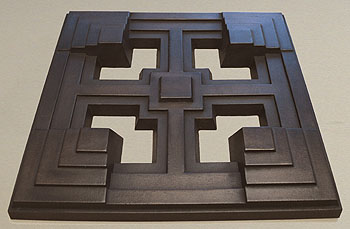 |
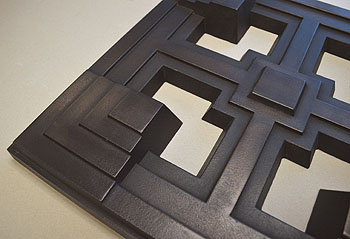 |
|
|
|
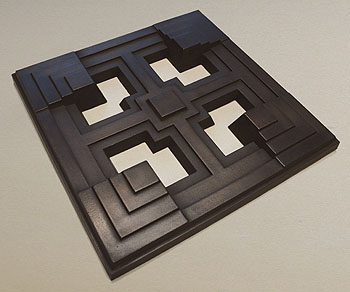 |
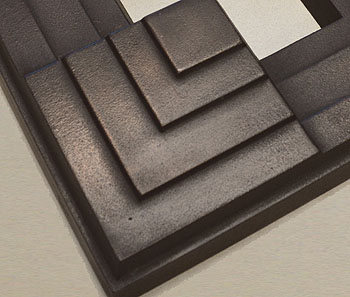 |
|
|
|
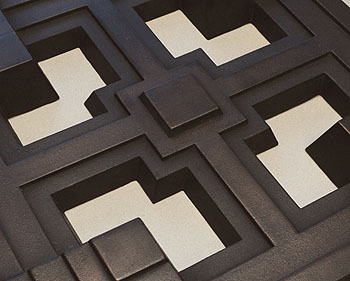 |
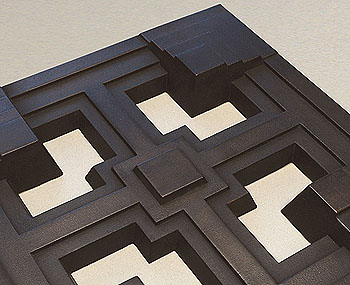 |
|
|
|
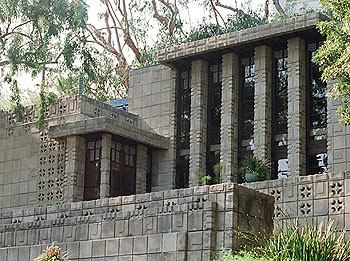
|
Date:
1995
Title:
John Storer Residence, 1995
(1923 - S.215).
Description:
The Storer Residence was Frank Lloyd Wright’s second
textile block home in California: 1) Millard (La Miniatura), 3)
Freeman, 4) Ennis. The house was originally designed in 1922 for
Charles P. Lowes, Eagle Rock, California, but was never built.
Wright adapted the plan, made modifications and designed it for
the Storer property. A two-story home, the Entrance, Dining
Room, Kitchen, two Bedrooms and Terraces are on the main floor.
The upper level includes the Living Room, directly above the
Dining Room, two bedrooms as well as two Terraces. From the
street, the Living and Dining rooms appear to be a single room,
with unbroken windows running from ground to roof. Wright’s son
Lloyd Wright supervise the construction of the home. There are
four different textile blocks...
Continue...
Size: Original 6" x 4" Color Photograph and 13" x
9" High Res Digital Image.
ST#:
1995.83.1015 1-24 |
|
|
|
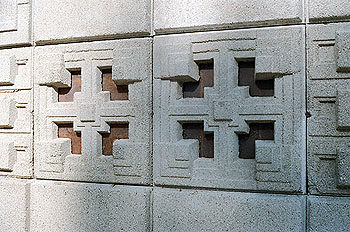 |
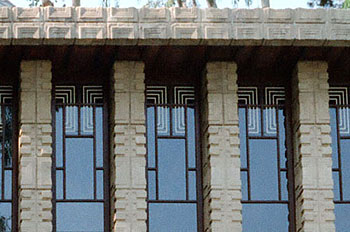
Continue to additional photographs. |
|
|
|
|
|
|
|
|
|
|
JOHN
STORER RESIDENCE (1995) |
|
|
|
The
Storer Residence was Frank Lloyd Wright's second textile
block home in California: 1) Millard (La Miniatura), 3)
Freeman, 4) Ennis. The house was originally designed in 1922
for Charles P. Lowes, Eagle Rock, California, but was never
built. Wright adapted the plan, made modifications and
designed it for the Storer property. A two-story home, the
Entrance, Dining Room, Kitchen, two Bedrooms and Terraces
are on the main floor. The upper level includes the Living
Room, directly above the Dining Room, two bedrooms as well
as two Terraces. From the street, the Living and Dining
rooms appear to be a single room, with unbroken windows
running from ground to roof. Wright's son Lloyd Wright
supervise the construction of the home. There are four
different textile blocks designs were used to construct the
Storer House and are 16" x 16" square. Glass was added to
the perforated blocks allowing additional light in, creating
patters of light on the interior. Glass was added to the
exterior perforated blocks, and illuminated at night. Wright
also added landscape walls to create Terraces and Planting
areas surround the house. Horizontal and vertical steel rods
were woven around each block. The horizontal and vertical
grooves between each block were filled with concrete,
locking the blocks in place. Wright specified the concrete
block mix of four parts building sand and decomposed granite
to one part Portland cement. The window design included wood
sash bars, and flat lead painted white.
Frank Lloyd Wright wrote: "The
Concrete block? the cheapest (and ugliest) thing in the
building world. It lived mostly in the architectural gutter
as an imitation of 'rock face' stone. |
|
Why not see what could be done with the
gutter-rat? Steel wedded to it cast inside the joints and
the block itself brought into some broad, practical scheme
of general treatment then why would it not be fit for a
phase of modern architecture? it might be permanent, noble,
beautiful. It would be cheap...
"All that imagination needed to make such a scheme feasible
was a plastic medium where steel would enter into inert mass
as a tensile strength. Concrete was the inert mass and would
take compression. Concrete is a plastic material --
susceptible to the impress of imagination. I saw a kind of
weaving coming out of it. Why not weave a kind of building?
Then I saw the 'shell.' Shells with steel inlaid in them. Or
steel for warp and masonry units for 'woof' in the weaving.
For block size -- say manhandled units weighing 40 to 50
pounds -- all such units or blocks for either weaving or
shells to be set steel-wound and steel-bound. Floors,
ceilings, walls all the same -- all to be hollow...
"We would take that despised outcast of the building
industry -- the concrete block -- out from underfoot or from
the gutter -- find a hitherto unsuspected soul in it -- make
it live as a thing of beauty -- textured like the trees.
Yes, the building would be made of the 'blocks' as a kind of
tree itself standing at home among the other trees in its
own native land." Frank Lloyd Wright, An
Autobiography,
1932, p.235, 241.
This set of 24 photographs taken during a trip to California
in 1995. Original 6" x 4" Color Photograph and 13" x 9" High
Res Digital Image. |
|
| |
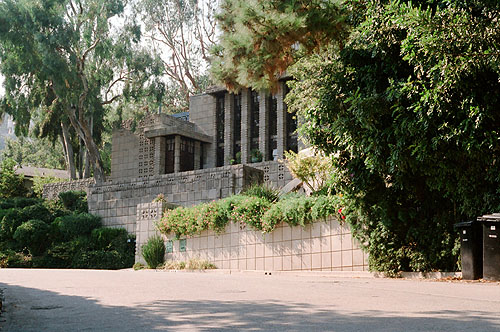 |
|
1)
John Storer Residence, 1995. Viewed from the
Southeast. The Bedroom is on the left, the Dining
and Living rooms are seen to the right. They appear
to be a single room, with unbroken windows running
from the ground to the roof. Windows are separated
by vertical block columns. The Storer Residence was
Frank Lloyd Wright’s second textile block home in
California: Original 6" x 4" Color Photograph and
13" x 9" High Res Digital Image. (ST#1995.83-1)
|
| |
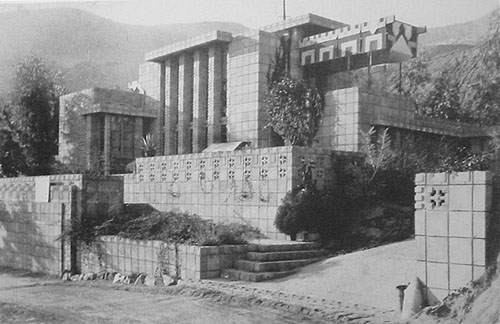 |
|
John
Storer Residence, circa 1924. Viewed from the
Southeast. Designed by Frank Lloyd Wright in 1923,
the home was completed in 1924. Most likely
photographs shortly after the completion of
construction.
Wright's
son Lloyd Wright supervise the construction of the
home as well as designing the landscape. The
entrance of the home is reached by the stairs in the
foreground. 7 x 5 B&W
Photograph. |
| |
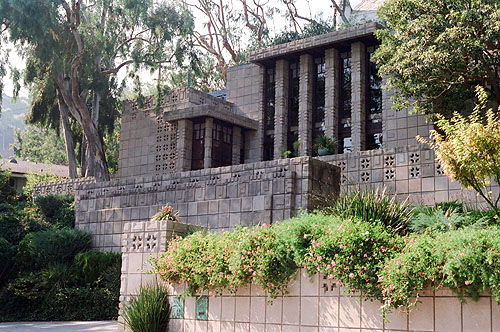 |
|
2)
John
Storer Residence, 1995. Viewed from the Southeast.
The Bedroom is on the left, the Dining and Living
rooms are seen to the right. They appear to be a
single room, with unbroken windows running from the
ground to the roof. The Entrance is just to the
right of the Bedroom. Windows are separated by
vertical block columns. Original 6" x 4" Color
Photograph and 13" x 9" High Res Digital Image.
(ST#1995.83-2) |
| |
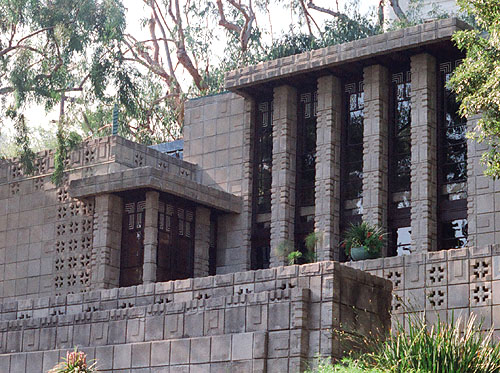 |
|
2B)
Detail of the Bedroom and Living and Dining rooms. |
| |
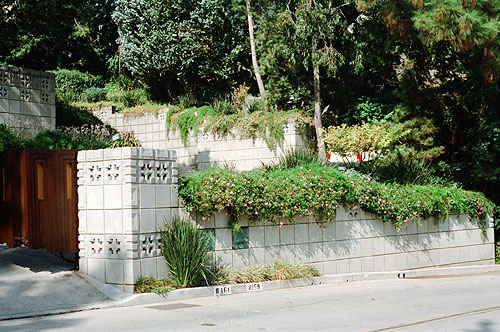 |
|
3)
John
Storer Residence, 1995. Viewed from the South.
Four styles of textile blocks are visible within the
gate pier. Original 6" x 4" Color
Photograph and 13" x 9" High Res Digital Image.
(ST#1995.83-3) |
| |
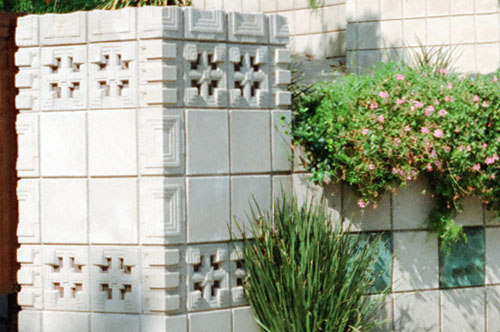 |
|
3A)
Detail of the gate pier. |
| |
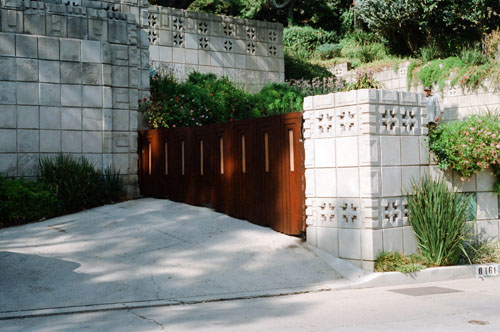 |
|
4)
John
Storer Residence, 1995. Viewed from the South.
The drive leads past the gate, and around to the
back of the house where the back entrance and garage
are. Original 6" x 4" Color
Photograph and 13" x 9" High Res Digital Image.
(ST#1995.83-4) |
| |
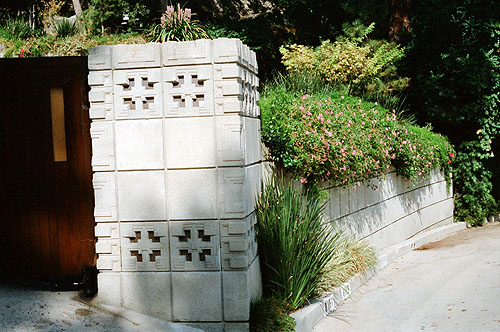 |
|
5)
John
Storer Residence, 1995. View of the southern
perimeter wall, from the Southwest.
Original 6" x 4" Color
Photograph and 13" x 9" High Res Digital Image.
(ST#1995.83-5) |
| |
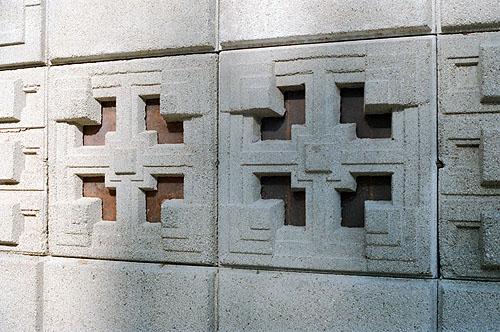 |
|
6)
John
Storer Residence, 1995. Detail of the perforated
textile blocks. Imbedded glass is illuminated at
night. Original 6" x 4" Color
Photograph and 13" x 9" High Res Digital Image.
(ST#1995.83-6) |
| |
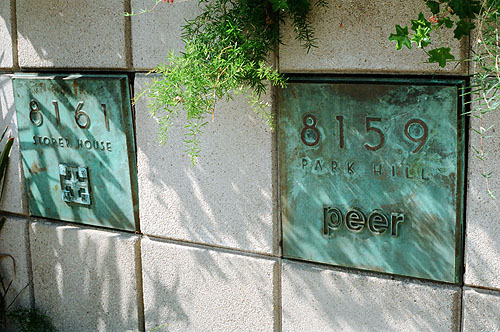 |
|
7)
John
Storer Residence, 1995. Address plaques embedded in
the
southern
perimeter wall. 8159 Park Hill is the home to the
East. Original 6" x 4" Color
Photograph and 13" x 9" High Res Digital Image.
(ST#1995.83-7) |
| |
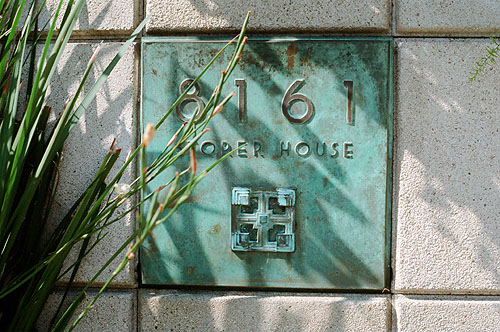 |
|
8)
John
Storer Residence, 1995. Address plaques embedded in
the
southern
perimeter wall. Original 6" x 4" Color
Photograph and 13" x 9" High Res Digital Image.
(ST#1995.83-8) |
| |
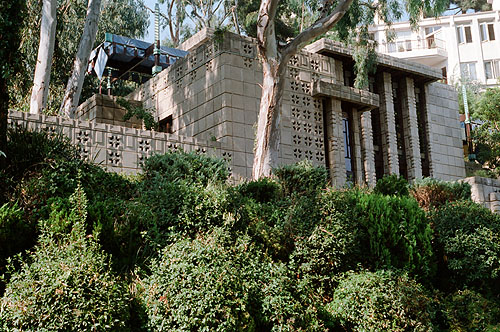 |
|
9)
John
Storer Residence, 1995. The Bath is on the left,
Bedroom in the center, and the Living and Dining
Rooms on the right. There is a Terrace above the
bedrooms that cover both. Original 6" x 4" Color
Photograph and 13" x 9" High Res Digital Image.
(ST#1995.83-9) |
| |
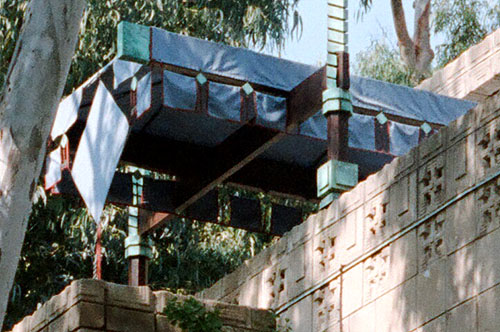 |
|
9A)
John
Storer Residence, 1995. Detail of the covering over
the Terrace. |
|
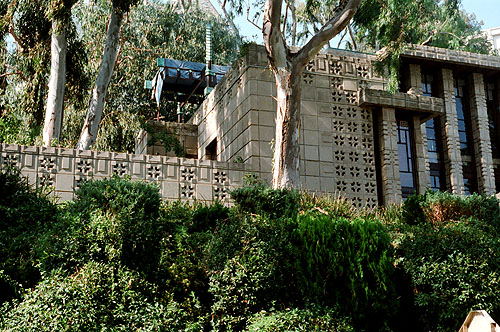 |
|
10)
John
Storer Residence, 1995.
Viewed
from the South. The Bath is on the left,
Bedroom in the center, and the Living and Dining
Rooms on the right. There is a Terrace above the
bedrooms that cover both. Original 6" x 4" Color
Photograph and 13" x 9" High Res Digital Image.
(ST#1995.83-10) |
|
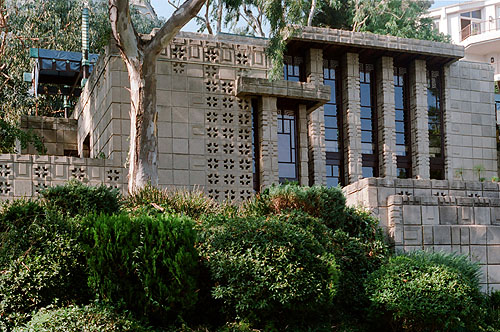 |
|
11)
John
Storer Residence, 1995. Viewed from the South.
Wright wove horizontal and vertical
steel rods around
each block, and filled the horizontal and vertical
grooves between each block with concrete, locking
the blocks in place. Original 6" x 4" Color
Photograph and 13" x 9" High Res Digital Image.
(ST#1995.83-11) |
|
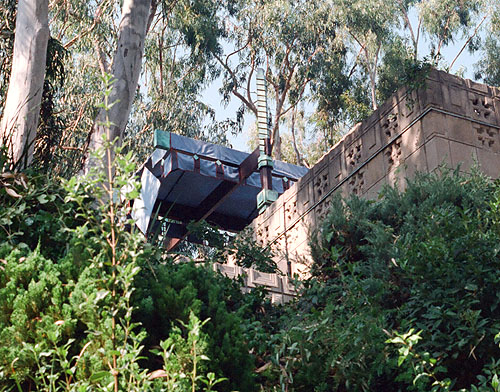 |
|
12)
John
Storer Residence, 1995. Wright specified the
concrete block mix of four parts building sand and
decomposed granite
to one part Portland cement. Original 6" x 4" Color
Photograph and 13" x 9" High Res Digital Image.
(ST#1995.83-12) |
|
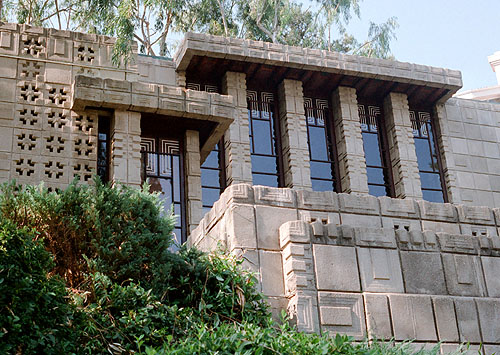 |
|
13)
John
Storer Residence, 1995. Viewed from the South. The
house was originally designed in 1922 for Charles P.
Lowes, Eagle Rock, California, but was never built.
Wright adapted the plan, made modifications and
designed it for the Storer property. Original 6" x 4" Color
Photograph and 13" x 9" High Res Digital Image.
(ST#1995.83-13) |
|
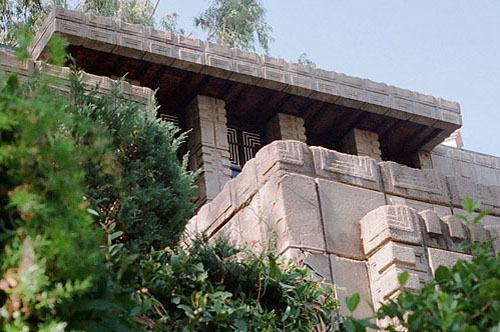 |
|
14)
John
Storer Residence, 1995.
Four
different textile blocks designs were used to
construct the Storer House. Block were 16" x 16"
square. Original 6" x 4" Color
Photograph and 13" x 9" High Res Digital Image.
(ST#1995.83-14) |
|
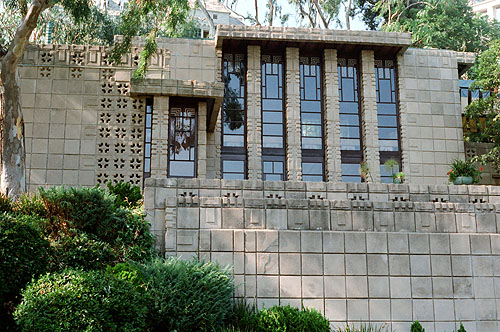 |
|
15)
John
Storer Residence, 1995.
The
Living and Dining Rooms almost appear to be a single
room. Tall vertical columns span both floors and are
separated by windows. Original 6" x 4" Color
Photograph and 13" x 9" High Res Digital Image.
(ST#1995.83-15) |
|
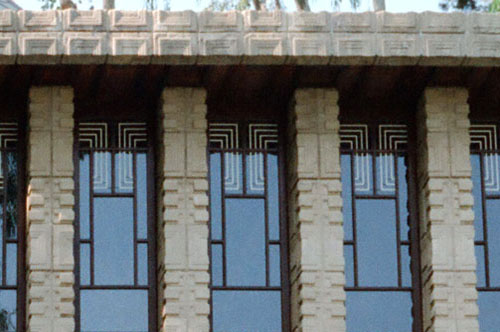 |
|
15A)
John
Storer Residence, 1995.
Detail of
the Living Room windows. Frank Lloyd Wright used wood sash bars
to create the design of the windows.
He also specified flat lead
painted white,
Monograph 4. Original 6" x 4" Color
Photograph and 13" x 9" High Res Digital Image.
(ST#1995.83-15) |
|
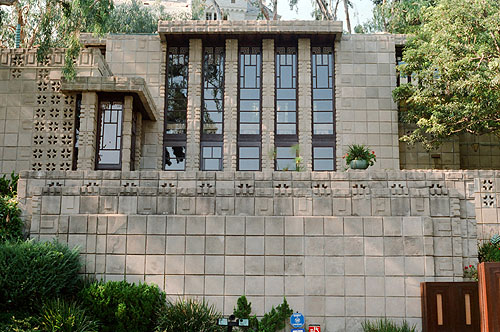 |
|
16)
John
Storer Residence, 1995.
Viewed
from the South. The
Bedrooms are on the left, the Living and Dining Rooms
are in the center and almost appear to be a single
room. Original 6" x 4" Color
Photograph and 13" x 9" High Res Digital Image.
(ST#1995.83-16) |
|
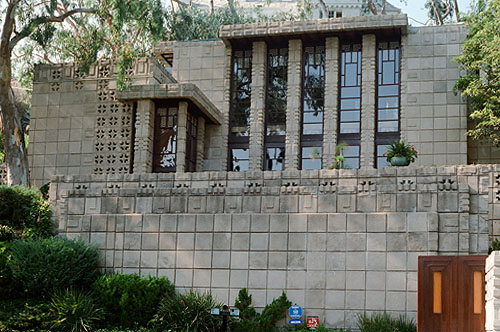 |
|
17)
John
Storer Residence, 1995.
Viewed
from the Southeast. The home has four bedrooms.
There are two bedrooms on the lower level to the
west (left)
side
of the Dining Room. The other two bedrooms are just
above on the west side of the Living Room. Original 6" x 4" Color
Photograph and 13" x 9" High Res Digital Image.
(ST#1995.83-17) |
|
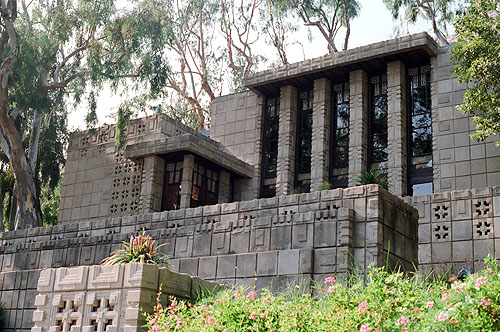 |
|
18)
John
Storer Residence, 1995.
Viewed
from the Southeast. "The Concrete block? the
cheapest (and ugliest) thing in the building world.
It lived mostly in the architectural gutter as an
imitation of 'rock face' stone. Why not see what
could be done with the gutter-rat? Steel wedded to
it cast inside the joints and the block itself
brought into some broad, practical scheme of general
treatment then why would it not be fit for a phase
of modern architecture? it might be permanent,
noble, beautiful. It would be cheap." Frank Lloyd
Wright, An
Autobiography, 1932, p.235. Original 6" x 4" Color
Photograph and 13" x 9" High Res Digital Image.
(ST#1995.83-18) |
|
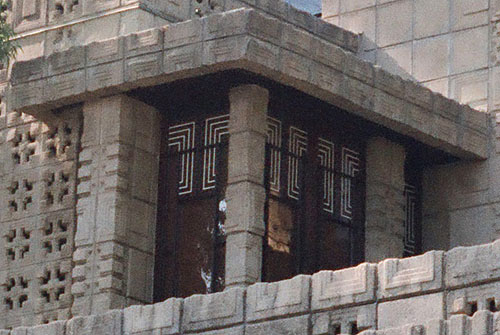 |
|
18B)
John
Storer Residence, 1995.
Detail of
the upper bedroom.
Frank
Lloyd Wright used wood sash bars to create the design of the windows
and doors. He also specified flat lead
painted white,
Monograph 4. |
|
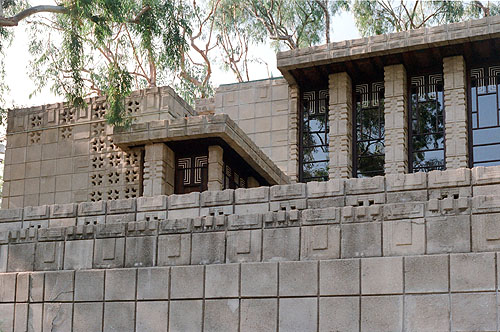 |
|
19)
John
Storer Residence, 1995.
Viewed
from the Southeast. "All that imagination needed to
make such a scheme feasible was a plastic medium
where steel would enter into inert mass as a tensile
strength. Concrete was the inert mass and would take
compression. Concrete is a plastic material --
susceptible to the impress of imagination. I saw a
kind of weaving coming out of it. Why not weave a
kind of building? Then I saw the 'shell.' Shells
with steel inlaid in them. Or steel for warp and
masonry units for 'woof' in the weaving. For block
size -- say manhandled units weighing 40 to 50
pounds -- all such units or blocks for either
weaving or shells to be set steel-wound and
steel-bound. Floors, ceilings, walls all the same --
all to be hollow." Frank Lloyd Wright,
An
Autobiography, 1932, p.235. Original 6" x 4" Color
Photograph and 13" x 9" High Res Digital Image.
(ST#1995.83-19) |
|
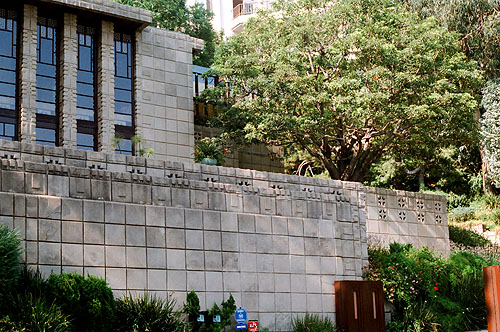 |
|
20)
John
Storer Residence, 1995.
Viewed
from the South. "We would take that despised outcast
of the building industry -- the concrete block --
out from underfoot or from the gutter -- find a
hitherto unsuspected soul in it -- make it live as a
thing of beauty -- textured like the trees. Yes, the
building would be made of the 'blocks' as a kind of
tree itself standing at home among the other trees
in its own native land." Frank Lloyd Wright,
An
Autobiography, 1932, p.241.
Original 6" x 4" Color Photograph and 13" x 9" High
Res Digital Image. (ST#1995.83-20) |
|
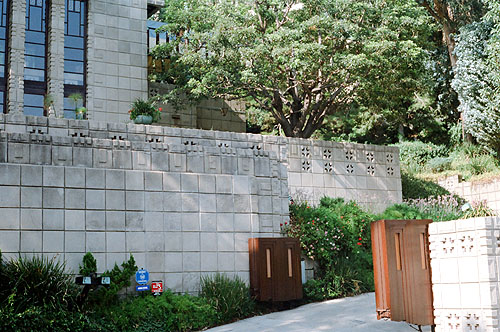 |
|
21)
John
Storer Residence, 1995. Viewed from the South.
The drive leads past the gate, and around to the
back of the house where the back entrance and garage
are. Original 6" x 4" Color
Photograph and 13" x 9" High Res Digital Image.
(ST#1995.83-21) |
|
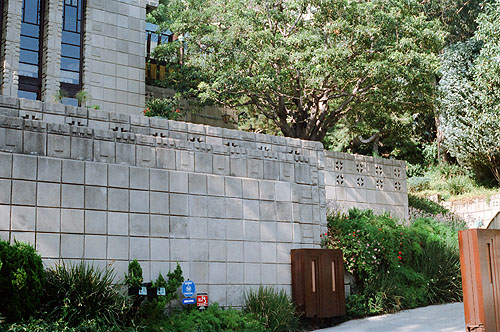 |
|
22)
John
Storer Residence, 1995. Built into the hillside,
Frank Lloyd Wright added walls to create Terraces
and Planting areas surround the house. Original 6" x 4" Color
Photograph and 13" x 9" High Res Digital Image.
(ST#1995.83-22) |
|
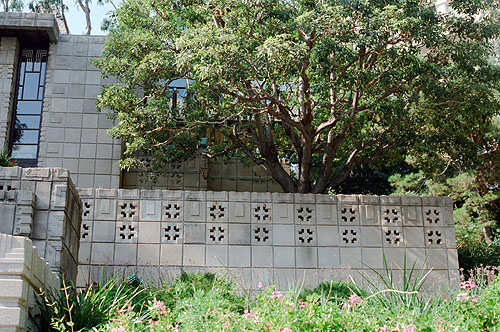 |
|
23)
John
Storer Residence, 1995.
Viewed
from the South. Perforated
textile blocks, imbedded with glass are illuminated at
night. Original 6" x 4" Color
Photograph and 13" x 9" High Res Digital Image.
(ST#1995.83-23) |
|
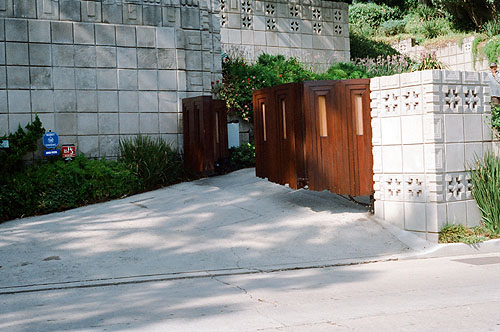 |
|
24)
John
Storer Residence, 1995. Viewed from the South.
Four styles of textile blocks are visible within the
gate pier. Original 6" x 4" Color
Photograph and 13" x 9" High Res Digital Image.
(ST#1995.83-24) |
| |
|
|
|
|
|
|
|
































































